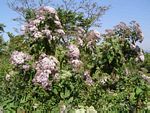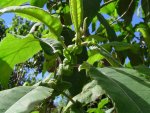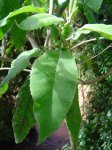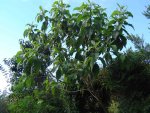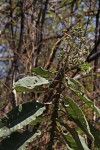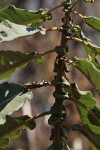Vernonia myriantha
Selected images: Click on each image to see a larger version and details of the record View all images (13)
Detailed records: Display species records QDS maps by: Google Maps Point records by Google Maps
Species details: Click on each item to see an explanation of that item (Note: opens a new window)
| Synonyms: |
Gymnanthemum myrianthum (Hook.f.) H. Rob. Vernonia ampla O. Hoffm. Vernonia podocoma Sch.Bip. ex Vatke Vernonia stipulacea Klatt Vernonia subuligera O. Hoffm. |
| Common names: | Eared vernonia (English) |
| Frequency: | Common |
| Status: | Native |
| Description: |
Large shrub or even small, soft wooded tree, 1.5-6 m. tall. Leaves grey-green velvety to hairy beneath, rarely becoming hairless, 10-38 cm. long; margins serrate. Capitula numerous, small, whitish, mauve to purple-pink, phyllaries ± equalling the mature achene in length, inner phyllaries falling in fruit; florets 5-15 per capitulum; achene obscurely angular and 6-8 ribbed, outer pappus of short setae, inner of fine white often long-exserted setae. Although often a "messy" shrub, it can be quite beautiful when in flower because the large inflorescences turn the whole shrub into a ball of colour varying from white to deep purple. |
| Type location: |
Cameroon |
| Notes: |
|
| Derivation of specific name: | |
| Habitat: | Rocky scrub and grassland. |
| Altitude range: (metres) | 700 - 1900 m |
| Flowering time: | Aug - Sep |
| Worldwide distribution: | Zambia, Tanzania, Malawi, Mozambique, Zimbabwe; widespread in tropical Africa, extending to KwaZulu-Natal. |
| FZ divisions: | N,W,C,E,S |
| Growth form(s): | |
| Endemic status: | |
| Red data list status: | |
| Insects associated with this species: | |
| Spot characters: | Display spot characters for this species |
| Images last updated: | Tuesday 1 February 2011 |
| Literature: |
Baumann, G. (2005). Photographic Guide to Wildflowers of Malawi Wildlife and Environmental Society of Malawi Pages 180 - 181. (Includes a picture). Burrows, J.E. & Willis, C.K. (eds) (2005). Plants of the Nyika Plateau Southern African Botanical Diversity Network Report No. 31 SABONET, Pretoria Page 111. Burrows, J.E., Burrows, S.M., Lötter, M.C. & Schmidt, E. (2018). Trees and Shrubs Mozambique Publishing Print Matters (Pty), Cape Town. Page 1028. (Includes a picture). Chapano, C. & Mamuto, M. (2003). Plants of the Chimanimani District National Herbarium and Botanic Garden, Zimbabwe Page 58. Chapano, C. & Mugarisanwa, N.H. (2003). Plants of the Matobo District National Herbarium and Botanic Garden, Zimbabwe Page 37. Dowsett-Lemaire, F. (1989). The flora and phytogeography of the evergreen forests of Malawi. I: Afromontane and mid-altitude forests; Bull. Jard. Bot. Nat. Belg. 59(1/2) Page 29. As Vernonia stipulacea Drummond, R.B. (1975). A list of trees, shrubs and woody climbers indigenous or naturalised in Rhodesia. Kirkia 10(1) Page 278. as Vernonia stipulacea Fischer, E. & Killmann, D. (2008). Illustrated Field guide to the Plants of Nyungwe National Park Rwanda. University of Koblenz-Landau. Page 244. (Includes a picture). Mapaura, A. & Timberlake, J. (eds) (2004). A checklist of Zimbabwean vascular plants Southern African Botanical Diversity Network Report No. 33 Sabonet, Pretoria and Harare Page 29. Ntore, S. & al. (2024). Checklist of the vascular plants of Burundi Page 66. Pope, G.V. (1992). Compositae Flora Zambesiaca 6(1) Pages 82 - 85. (Includes a picture). Shone, D.K. & Drummond, R.B. (1965). Poisonous Plants of Rhodesia Ministry of Agriculture, Rhodesia Pages 18 - 19. as Vernonia ampla (Includes a picture). Strugnell, A.M. (2006). A Checklist of the Spermatophytes of Mount Mulanje, Malawi Scripta Botanica Belgica 34 National Botanic Garden of Belgium Page 60. |
Other sources of information about Vernonia myriantha:
Our websites:
Flora of Burundi: Vernonia myrianthaFlora of Malawi: Vernonia myriantha
Flora of Mozambique: Vernonia myriantha
Flora of Rwanda: Vernonia myriantha
Flora of Zambia: Vernonia myriantha
External websites:
African Plants: A Photo Guide (Senckenberg): Vernonia myrianthaAfrican Plant Database: Vernonia myriantha
BHL (Biodiversity Heritage Library): Vernonia myriantha
EOL (Encyclopedia of Life): Vernonia myriantha
GBIF (Global Biodiversity Information Facility): Vernonia myriantha
Google: Web - Images - Scholar
iNaturalist: Vernonia myriantha
IPNI (International Plant Names Index): Vernonia myriantha
JSTOR Plant Science: Vernonia myriantha
Mansfeld World Database of Agricultural and Horticultural Crops: Vernonia myriantha
Plants of the World Online: Vernonia myriantha
Tropicos: Vernonia myriantha
Wikipedia: Vernonia myriantha
